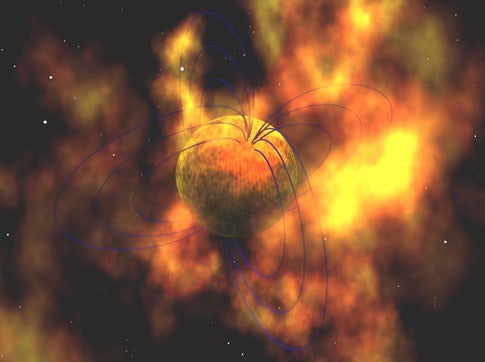On December 27, 2004, NASA’s Rossi X-ray Timing Explorer (RXTE) detected the most powerful X-ray flare ever seen from beyond the solar system. It was the product of a massive starquake on the highly magnetic neutron star SGR 1806-20. By studying X rays from that event, astronomers were able to measure the thickness of a neutron star’s crust for the first time. They hope future hyperflares will let them peer even deeper into the mysterious, super-dense cores of these collapsed stars.
Astrophysicists Tod Strohmayer at NASA’s Goddard Space Flight Center in Greenbelt, Maryland, and Anna Watts at the Max Planck Institute for Astrophysics in Garching, Germany, detected oscillations at particular frequencies in the X rays radiated by SGR-1806-20 for several minutes after the initial starquake. SGR 1806-20 is a magnetar, an intensely magnetized neutron star, located about 40,000 light-years from Earth, in the constellation Sagittarius. Theorists believe this kind of starquake is unleashed when tangled magnetic field lines suddenly sort themselves out, fracturing a star’s crust in the process.
Strohmayer and Watts think shear-waves from the quake twisting their way around the star showed up as 26 Hz and 90 Hz variations in the X rays, while oscillations resonating vertically within the crust produced a higher-frequency 626 Hz signal. Comparing these characteristic frequencies allowed them to calculate that the rigid crust, composed of the crunched-together nuclei of iron and similar elements, is about one-twelfth the diameter of the neutron star, or about a mile thick. They presented their findings at the April meeting of the American Physical Society, in Dallas, Texas.
“I’d probably stop short of saying that we have definitive proof, but the evidence looks quite good,” says Strohmayer. “The vibrations seem to be where theory says they should be.” He notes that GianLuca Israel at Italy’s National Institute of Physics independently detected the 90 Hz vibrations. Strohmayer and Watts also were able to confirm their RXTE measurements using a different space observatory, NASA’s Ramaty High Energy Spectroscopic Solar Imager.
Strohmayer is eager for more hyperflares to come along. Just as seismologists can use earthquake waves to study Earth’s interior, vibrations from within a neutron star may let astrophysicists test theories that describe the exotic matter deep within superdense stars. “We really don’t know the state of matter at these very high densities,” Strohmayer says. “It’s possible to answer those questions by studying the vibration modes of neutron stars — a way to see inside them.”
Theorist Tony Piro at the University of California, Santa Barbara, is equally positive. “We’ve been able to do this with the Earth and with the Sun,” he says. “We just have these few frequencies for this neutron star, but these are very exotic objects, so anything we can learn about them is very exciting.”










